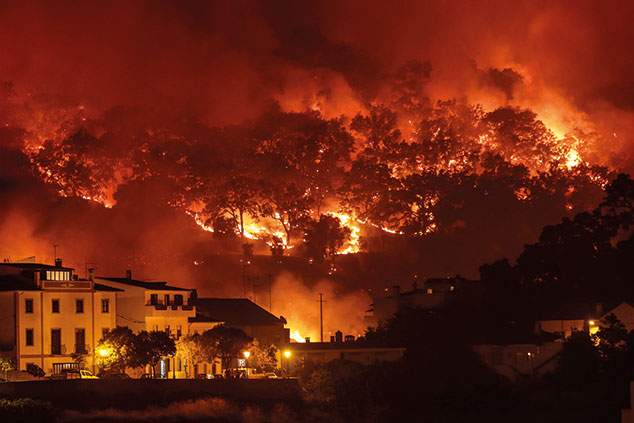
What’s happened?
Earlier this month – in the midst of the northern hemisphere heatwave that saw wildfires in the Arctic, temperatures above 40˚C in Japan, and vast swathes of Europe suffering crop failures and sweltering sleepless nights – an influential group of mainly Nordic climatologists published an apocalyptic warning about the future of the planet.
Currently, global temperatures are just over 1˚C above pre-industrial levels and rising at an average of 0.17˚C each decade. The Paris Agreement on climate change commits its signatories to actions aimed at keeping the rise from pre-industrial levels to a maximum of 2˚C by the end of the century.
But according to the climatologists’ paper, published in Proceedings of the National Academy of Sciences, there’s now a risk that even a “successful” attempt to limit climate change could in fact trigger a domino effect of unstoppable warming, putting into motion “positive feedback loops” that will lead to a cascade of melting ice, warming seas, shifting currents and dying forests, pushing the Earth into a “hothouse” state beyond which human efforts to cut emissions of warming gases would be futile.
What can we do?
We can cut emissions of greenhouse gases faster and harder. That remains the cheapest and easiest way of mitigating climate change. But the renewed fears sparked by this year’s global heatwave have also re-doubled interest in what’s known as “negative emissions technologies” (NETs). In essence, that means removing carbon dioxide from the atmosphere and putting it back into the ground or oceans, so that it can’t slowly cook the planet.
NETs are as yet unproven, speculative, and regarded by some as so wildly expensive as to be scarcely worth bothering with. And yet – in one of the grim ironies of global climatology – virtually all the pathways laid out by the UN’s International Panel on Climate Change (IPCC) for reaching the Paris target of limiting warming to 2˚C depend on massive deployment of NETs in the second half of the present century. There is widespread scepticism about the nascent technologies. And yet we are counting on them to deliver us from Armageddon.
What’s the scale of the task?
Vast. Because cuts in CO2 are expected to be too slow to reach zero emissions fast enough, about 12 billion tonnes of CO2 (on IPCC figures) will need to be captured and stored every year after 2050 – the equivalent of about a third of all global emissions today.
Negative emissions technologies range from the relatively straightforward (massive afforestation and reforestation projects) to the realms of sci-fi (seeding the stratosphere with sulphates or fertilising the ocean with iron filings). Other options being researched include “enhanced weathering”: this involves spreading pulverised rocks onto soils and/or the ocean to ramp up the natural rock weathering process that takes up CO2 from the atmosphere and ultimately wash it into the ocean as bicarbonate.
Are there other options?
One is biochar. This involves burning biomass (including agricultural waste; a major source of greenhouse gases) in the absence of oxygen to create a form of charcoal (biochar) that holds onto carbon for hundreds or thousands of years, while also enriching soils. The most mainstream NET – in the sense that it’s the one IPCC mitigation scenarios rely on most heavily – is “bioenergy with carbon capture and storage” (BECCS).
This involves growing trees (which take CO2 from the atmosphere) then burning them to produce electricity while capturing emissions and burying them. The most high-tech plan, though, is “direct air capture” (DAC). The idea of sucking CO2, if viable, could prove the ultimate negative emissions technology. It is mostly dismissed as impractical and expensive, but a new academic paper in the journal Joule gives some grounds for hope.
What does it say?
The paper, published in June, reports the findings of a company called Carbon Engineering, based in Calgary in Canada, and whose chief scientist is a Harvard climate physicist, David Keith. The firm was founded in 2009 and has been running DAC tests since 2015.
The paper sets out its method and experiences, and puts forward an economic analysis that estimates that the cost of capturing a ton of CO2, which was previously estimated at around $600, has fallen to between $94 and $232. That’s not yet cheap enough to make it economically viable. But it’s a big step in the right direction.
How does direct capture work?
In effect, explains Robinson Meyer in The Atlantic, Keith and his colleagues have “grafted a cooling tower onto a paper mill”. The technical process involved has three major steps. First, outside air is sucked into “contactors” (akin to industrial cooling towers) using large fans, and exposed to an alkaline liquid, which absorbs the carbon dioxide (acting as a weak acid) from the air.
Second, the now watery liquid undergoes a series of chemical reactions to separate the alkaline base from the acid (similar to the process, integral to making paper, in which CO2 is removed from a carbonate solution). To do this, the liquid is frozen into solid pellets, slowly heated, and converted into a slurry.
Finally, explains Meyer, the CO2 is combined with hydrogen and converted into liquid fuels, including gasoline, diesel, and jet fuel. Again, this is not an exceptional process nor hard to understand: oil companies convert hydrocarbon gases into liquid fuels every day. But it’s the key to Carbon Engineering’s ability to produce “carbon-neutral hydrocarbons”. Siphoning CO2 out of the atmosphere is not a magic answer to the problem of climate change – but nor, perhaps, is it merely a load of hot air.